Kenya: Part VII (Sweetwaters)
Apr. 10th, 2011 08:59 pmOn the way to Sweetwaters we stopped to take a look at the Thomson Falls. Actually, we had to go to the bathroom and the falls just happened to be conveniently located next to the nearest facilities. They recently started charging for access to the falls and they are completely not worth the price. On top of being rather lame, they are surrounded by souvenir shops and you get accosted by a crowd of people aggressively trying to sell you something. I ended up being photographed with some guys posing in Kikuyu costume, and with chameleons, (who were much cuter than the fake tribesmen) but you can find and manhandle them completely free if you just rummage around the surrounding greenery.


Upon return to Nairobi when asked how I liked the falls I uncharitably replied that I've seen Niagara Falls.

If you are into falls, go see Fourteen Falls in Thika or, better yet, Victoria Falls in Zimbabwe.
Sweetwaters Tented Camp came closest to having actual tents of all the accommodations we encountered on the trip and it still had electricity, running hot water and other conveniences. (I am totally not complaining here.) Our tent was on stilts but they also have ones sitting on the ground.

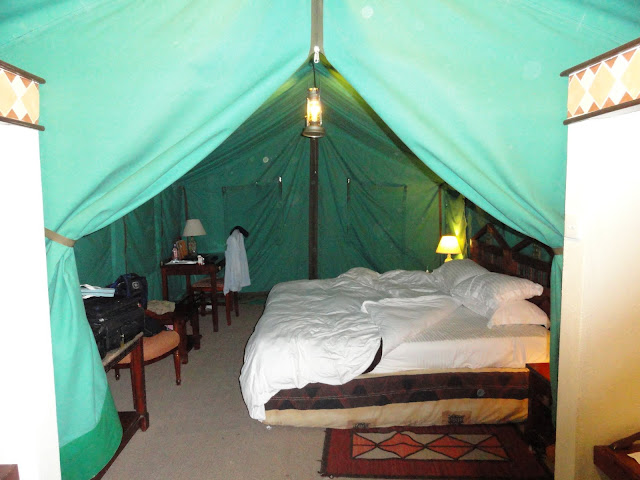

The landscape is quite lovely and there were lots of different varieties of birds walking around.
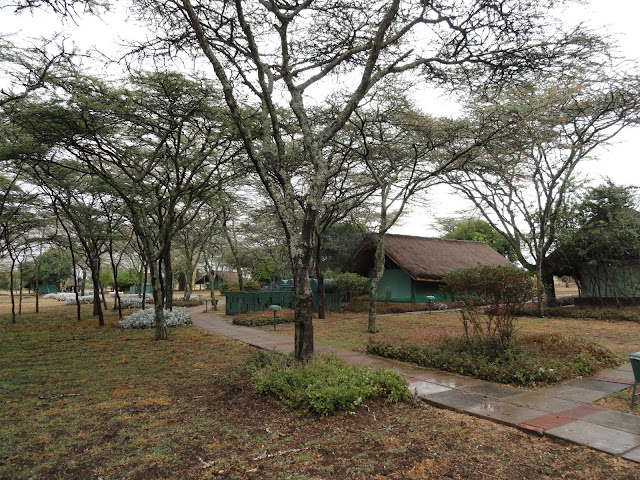
Marabou Storks

Grey Crowned Cranes, African Sacred Ibis, Egyptian Geese and some other ones I didn't recognize

Egyptian Geese in Africa seem to be the equivalent of Canadian Geese in our parts, a common nuisance that is.
As had become customary, following lunch we went on a game drive. First stop was a chimp preserve. Sweetwaters Chimpanzee Sanctuary is part of the Ol Pejeta Conservancy, situated between the foot hills of the Aberdares and Mount Kenya. It is the only place in Kenya where one can see endangered chimps, they are not indigenous to the area. It's been functional since 1993 and provides refuge to animals rescued from various man-made hostile situations, including civil war in Burundi. In Sweetwaters chimps are given a large open space in which to live, about 250 acres, and are taught how to fend for themselves with some assistance from humans. For instance, in the wild chimps eat small birds and rodents, in captivity some still hunt for prey but only for fun, so people have to provide them with required proteins.
Structure chimps use as their home

The electric fence surrounds chimp habitat. Keepers throw peanuts to encourage the animals to hang out in front of the fence so the visitors can see them.

Chimps don't normally stand up straight, but this one, Pokos, was kept in a small cage as a baby which forced him to learn to stand. He is one of the refugees from Burundi.


He also used to be a leader of the pack until he lost a fight to a younger male.



There are also lots of baboons in the area, but since they are not endangered they just roam around without extra supervision

It rained right before we left for the drive and the double benefit of that was lack of dust and a beautiful rainbow.




Conservancy has another fenced area that houses a black rhino. It used to be a home to Morani, which N. and his family remember very fondly. It was an unusually friendly rhino having been with humans since its birth and visitors were allowed to closely interact and pet it. Unfortunately she recently passed away. Her replacement, Baraka, which means blessings in Swahili, is the first black rhino that was born in the wild in the Conservancy. He went blind and now can't live in the wild. He is not particularly friendly.


Baraka was all intent on leaving the viewing area so the keeper had to induce him to stay, by whatever means necessary.
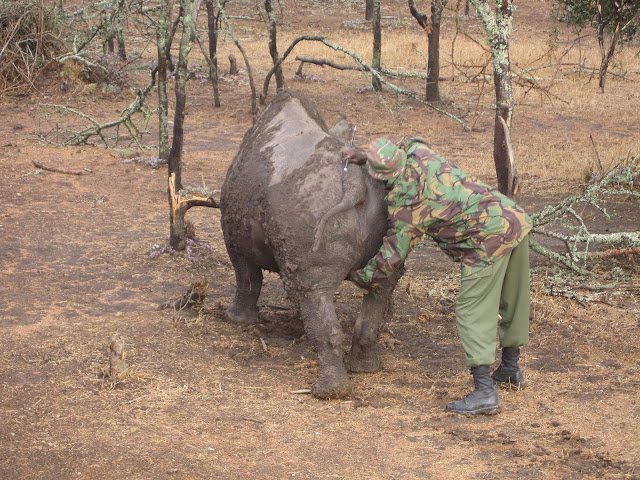


Later on, late in the evening and at some distance we were lucky to see some rhinos in the wild as well, mother with a baby.

After enjoying fresh early morning in the camp and devouring a delicious breakfast we left for our final destination, but first took a last game drive.
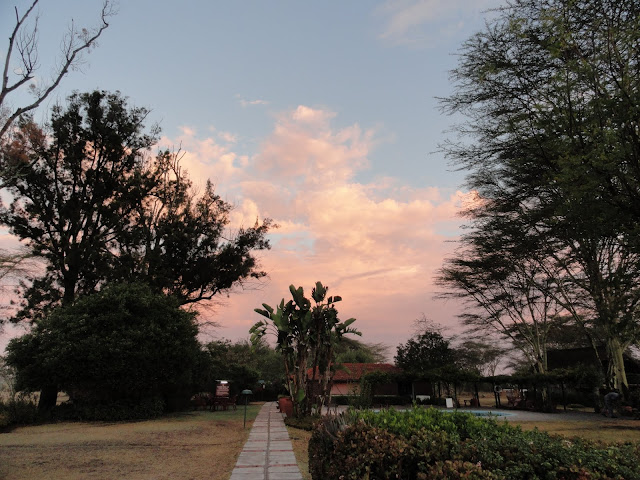
When crossing a bridge over what's probably going to be a river later in the rain season we discovered that park rangers have very high opinions of local elephants. They are convinced at least some of them can read.

Female waterbuck with a baby

The horizon in this picture is beyond salvation but nobody was looking at the horizon.
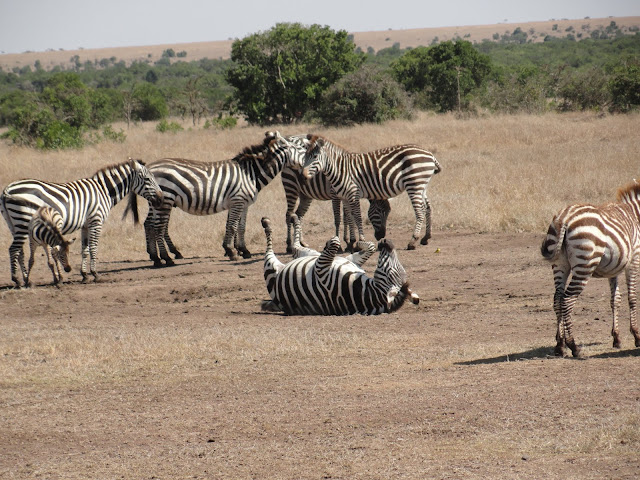
You would think this was just another picture of zebras. And you would be right and wrong at the same time. Take a look at the solitary zebra in the background. Notice anything odd? This is in fact a Gravy's zebra, a more rare variety of zebras. We were on the lookout for these zebras our whole time in Sweetwaters but kept running into the herds of regular zebras. And then we came home and started sorting through the pictures... What was meant to be a picture of a zebra with a foаl turned into a picture of a very lonely Gravy's zebra.
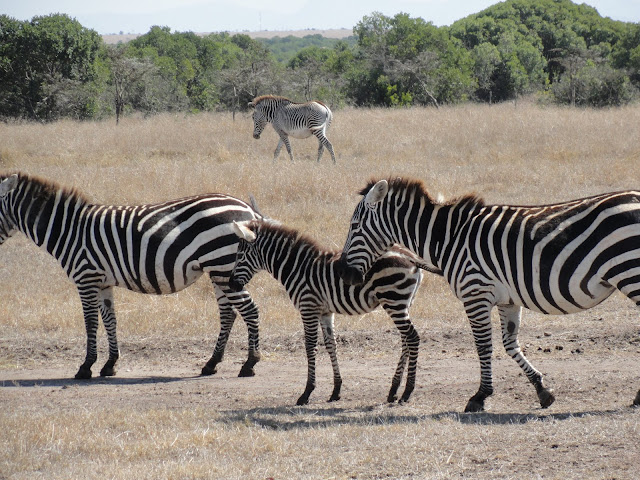
On the way out we also stopped by the Ol Pejeta House which is famous for having been a home to Adnan Khashoggi, the arms dealer. We were not allowed in due to construction but usually for a price you can stay in one of the six available luxury suites.
Upon return to Nairobi when asked how I liked the falls I uncharitably replied that I've seen Niagara Falls.

If you are into falls, go see Fourteen Falls in Thika or, better yet, Victoria Falls in Zimbabwe.
Sweetwaters Tented Camp came closest to having actual tents of all the accommodations we encountered on the trip and it still had electricity, running hot water and other conveniences. (I am totally not complaining here.) Our tent was on stilts but they also have ones sitting on the ground.
The landscape is quite lovely and there were lots of different varieties of birds walking around.
Marabou Storks
Grey Crowned Cranes, African Sacred Ibis, Egyptian Geese and some other ones I didn't recognize
Egyptian Geese in Africa seem to be the equivalent of Canadian Geese in our parts, a common nuisance that is.
As had become customary, following lunch we went on a game drive. First stop was a chimp preserve. Sweetwaters Chimpanzee Sanctuary is part of the Ol Pejeta Conservancy, situated between the foot hills of the Aberdares and Mount Kenya. It is the only place in Kenya where one can see endangered chimps, they are not indigenous to the area. It's been functional since 1993 and provides refuge to animals rescued from various man-made hostile situations, including civil war in Burundi. In Sweetwaters chimps are given a large open space in which to live, about 250 acres, and are taught how to fend for themselves with some assistance from humans. For instance, in the wild chimps eat small birds and rodents, in captivity some still hunt for prey but only for fun, so people have to provide them with required proteins.
Structure chimps use as their home
The electric fence surrounds chimp habitat. Keepers throw peanuts to encourage the animals to hang out in front of the fence so the visitors can see them.
Chimps don't normally stand up straight, but this one, Pokos, was kept in a small cage as a baby which forced him to learn to stand. He is one of the refugees from Burundi.

He also used to be a leader of the pack until he lost a fight to a younger male.

There are also lots of baboons in the area, but since they are not endangered they just roam around without extra supervision
It rained right before we left for the drive and the double benefit of that was lack of dust and a beautiful rainbow.

Conservancy has another fenced area that houses a black rhino. It used to be a home to Morani, which N. and his family remember very fondly. It was an unusually friendly rhino having been with humans since its birth and visitors were allowed to closely interact and pet it. Unfortunately she recently passed away. Her replacement, Baraka, which means blessings in Swahili, is the first black rhino that was born in the wild in the Conservancy. He went blind and now can't live in the wild. He is not particularly friendly.
Baraka was all intent on leaving the viewing area so the keeper had to induce him to stay, by whatever means necessary.
Later on, late in the evening and at some distance we were lucky to see some rhinos in the wild as well, mother with a baby.
After enjoying fresh early morning in the camp and devouring a delicious breakfast we left for our final destination, but first took a last game drive.
When crossing a bridge over what's probably going to be a river later in the rain season we discovered that park rangers have very high opinions of local elephants. They are convinced at least some of them can read.
Female waterbuck with a baby
The horizon in this picture is beyond salvation but nobody was looking at the horizon.
You would think this was just another picture of zebras. And you would be right and wrong at the same time. Take a look at the solitary zebra in the background. Notice anything odd? This is in fact a Gravy's zebra, a more rare variety of zebras. We were on the lookout for these zebras our whole time in Sweetwaters but kept running into the herds of regular zebras. And then we came home and started sorting through the pictures... What was meant to be a picture of a zebra with a foаl turned into a picture of a very lonely Gravy's zebra.
On the way out we also stopped by the Ol Pejeta House which is famous for having been a home to Adnan Khashoggi, the arms dealer. We were not allowed in due to construction but usually for a price you can stay in one of the six available luxury suites.
no subject
Date: 2011-04-11 03:02 am (UTC)By the way, baraka = bracha, так что на самом деле что носорога, что президента зовут просто-напросто Барух. :)
Also, zebra with a foal, not fowl.
no subject
Date: 2011-04-11 03:08 am (UTC)Obama should be very flattered by that observation, I am sure. Напоминает мне, как папа звал одного знакомого Борю Степой, на что тот очень обижался.
no subject
Date: 2011-04-11 03:26 am (UTC)You telling them about Niagara reminded me of a story that I wanted to tell you back at
The president of the company I used to work at, one Sumit Kumar Nagpal, married an American girl, and off they went to see her parents who live in Arizona.
After seeing the Great Canyon, Kristy found Sumit not as impressed with its grandeur as she hoped he'd be. When asked why, he shrugged apologetically and said:
"But honey, I grew up in the Himalayas."
no subject
Date: 2011-04-11 03:44 am (UTC)no subject
Date: 2011-04-11 03:49 am (UTC)Oh wait...
no subject
Date: 2011-04-11 03:09 am (UTC)no subject
Date: 2011-04-11 03:51 am (UTC)no subject
Date: 2011-04-11 03:52 am (UTC)no subject
Date: 2011-04-11 03:54 am (UTC)no subject
Date: 2011-04-11 03:08 am (UTC)Внимание, вопрос! Восстановите первый пропуск.